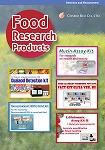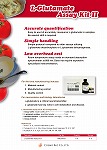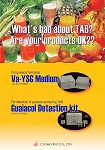this page: Food and Beverage Related Assays and Reagents Dashboard
Products on this page
Fruit Juice Quality Control
Common Allergen Lateral Flow Assays
Common Pathogen Lateral Flow Assays
Water Quality
Assays
Oxidative Stress
Analytical Standards
Product Brochures
Food and Juice Related Research Products
Common Food Allergen Detection: "FAST KIT ELISA Ver. III" and "FastKit Slim" (research use only)
* L-Glutamate Assay Kit II
* L-Glutamate Oxidase 25 Enzyme
Fruit Juice Quality Control

- Guaiacol Detection Kit
- A kit based on a test developed by the Japan Fruit Juice Association, detects contamination with Alicyclobacillus acidoterrestris and related Thermo-acidophilic Bacilli (TAB) by their production of guaiacol.
- Va-YSG Medium
- YSG Agar Plate
Va-YSG Medium is optimized for use with the Guaiacol Detection Kit (KYO-08921). Containing yeast extract (for vitamins and growth factors), glucose (as an energy source), soluble starch (for detoxification of metabolic by products) and vanillic acid, this low pH medium promotes Alicyclobacilli growth from fruit juices and facilitates their production of guaiacol.
Alicyclobacillus acidoterrestris, first isolated from soil, is a gram-positive, spore-forming bacillus that briefly gained notoriety after a publicized 1984 incident of apple juice turbidity. Resistance to high heat and acidic environments allows this thermo-acidophilic bacillus (TAB) to withstand fruit washing and juice thermal processing, to grow and spoil acidic foods with production of the pungent compound 2-methoxyphenol (guaiacol), 2,6-dibromophenol, and 2,6-dichlorophenol. [1, 2, 3].
Due to their production of guaiacol, TAB are a constant and significant threat to quality degradation in the production of juices and other products where flavor and odor are important. Even without the distracting flavor problem, product quality may be degraded by slight deterioration during distribution.
TAB contamination is difficult to avoid. Fortunately, A. acidocaldarius and other species that cause contamination are known to be harmless, and the costly spoilage threat posed by TAB can be minimized by vigilantly monitoring for A. acidoterrestris contamination. Given the frequent occurrence of fruit juice deterioration incidents in Europe and other regions, Japan Fruit Juice Association developed and publicized a unified test method for TAB in March 2003 [4]. To promote easy performance of this test, we developed a kit that detects A. acidoterrestris directly in terms of guaiacol production.
Kit Components
YSG Agar Plate 20 plates (Cat. No. KYO-06810)
YSG agar medium for TAB isolation 10 x 2 plates/1 box
Va-YSG Medium (2mL) 100 tubes (Cat. No. KYO-08901)
Vanillic acid added YSG medium for guaiacol formation 2 mL x 100 tubes
Guaiacol Detection Kit 100 tests (Cat. No. KYO-08921)
Reagent 1: 50mM Potassium Hydrogen Phthalate Buffer 60 mL x 2 bottles
Reagent 2: 1.3 % Hydrogen Peroxide Solution 2.5 mL x 1 tube
Reagent 3: Peroxidase-Phosphoric Acid Buffer 2.5 mL x 1 tube
Positive Control: Guaiacol (1050 ppm) 2.5 mL x 1 tube
Brown color indicates contamination of AAT 1.Negative Control 2. A. acidoterrestris B2067 3. A. acidoterrestris ATCC49025T 4. A. acidocaldarius ATCC27009T 5. A. acidocaldarius HP2 6. A. genomic sp. P2 7. A. genomic sp. DSM11983
Frequently Asked Questions
Q I have some questions on the TAB enumeration method available on the Cosmo-bio website.
a. What does YSG distilled water mean, I would like to know the preparation ratio.
b. For positive / negative test: in Sample preparation step its mentioned as Dilute with YSG medium, what’s the dilution ratio.
c. Is the same method applicable for Water samples?
A a. What does YSG distilled water mean, I would like to know the preparation ratio.
b. For positive / negative test: in Sample preparation step its mentioned as Dilute with YSG medium, what’s the dilution ratio.
Answer(a,b):
Sorry that, "YSG distilled water" was a wrong description, the correct one should be "distilled water". As for preparation ratio, please refer to the following ratio as a reference, though considering the ratio case by case is strongly recommended. (Reference data is from Japan Juice association).
------------------------------------------------------------------------------------------------
Juices 〔Brix value〕 reference ratio
-------------------------------------------------------------------------------------------------
Apple 〔70〕 ・・・・・・・・ 10 times
Orange 〔65〕 ・・・・・・・・ 10 times
Red grapes 〔65〕 ・・・・・・・・ 20-50 times
White grapes 〔65〕 ・・・・・・・・ 20 times
Carrot 〔40〕 ・・・・・・・・・10 times
Lemon 〔50〕 ・・・・・・・・・10 times
Grape fruits 〔55〕 ・・・・・・・・・20 times
Peach 〔55〕 ・・・・・・・・・10 times
-------------------------------------------------------------------------------------------------
c. Is the same method applicable for Water samples?
Answer(c): Sorry, we can not tell clearly whether it is applicable or not, since there is no such records yet. By the way, there is a soft drink called "near water". It was made from flavoring, non juice(or small amount) and water. We heard that our products have been tested for this kind of drinks.
Q Can fructose be used as a sample?
A Unfortunately, we do not have any knowledge about Guaiacol detection with sugar (fructose) sample. So, we propose a simple protocol modified from “Japanese spore counting method of sugar samples”. If you have your own protocol for pretreatment of bacteriological test, please use your protocol instead of “Sample preparation” in the protocol. In the protocol, there is a preparative method of YSG liquid medium. If you use the protocol proposed by us, you do not need to use inoculation loops and YSG agar plate.
Q We use your kit to confirm Alicyclobacillus acidoterrestris. One of our customers makes Mexican salsa and they have an off-flavor similar to guaiacol. Can we use your test kit to detect guaiacol in the salsa (tomato base, red color)? Would the red color interfere?
A Unfortunately, we don't have information for guaiacol detection kit usage with salsa sauce.
If you consider the inspection method by your self, please see the following "Matter of concerns" for your information. Matter of concern(1): Solid body derived from a sample If there are AAT in the solid body of the sample, stomaching processing or homogenizing processing have to be done and have to exude germs from the solid body.
Matter of concern(2):Influence of polyphenols derived from materials Polyphenols is Growth inhibitor of the AAT(Alicyclobacillus acidoterrestris). Therefore, you have to dilute samples 20-50 times to detect AAT. Otherwise, you can't detect it. We don't know how much polyphenols are included in salsa. But tomato is known to contain much polyphenols . Generally, dilution ratio is 10 times. But please consider to dilute salsa to over 20 times.
Matter of concern(3):About the viscosity of the sample Viscosity decreases with dilution. Therefore sample have to be diluted appropriately. Please dilute samples referring to the examinations of microbe dilution ratios except the examination of heat-resistant acidophilic bacteria.
Matter of concern(4):about the pigment carry over from sample to a specimen When you finally take the peroxidase method, and when the brown color samples are carried over, it might be hard to do a judgment. But I think it does not become the fatal problem because the sample will be diluted.
Matter of concern(5):Other interference materials When you finally use the peroxidase method, guaiacol (a production of AAT which causes the off fravor) polymerizes by a peroxidase reaction and becomes brown. We think salsa sauce includes various spices as a materials. Therefore, if there are materials inhibiting the peroxidase reaction or contains substances which acts like peroxidase that becomes brown by the peroxidase reaction, this will cause a false-positive or false-negative reaction.
Q Could you recommend how to inoculate TAB on YSG agar plate? Please offer its procedure.
A There are three ways of inoculate TAB under Japan Fruit Juice Association.
1) Pour Plate Method
2) Spread Plate Method with bent glass rod
3) MF Method
We might be able to introduce the recommend way, if you let us know your customer's sample and method of examination. For your information, please let us show the scheme of TAB test which is described in our brochure.
Q Do you also supply YSG medium without vanilic acid?
A Yes, we can provide YSG medium without vanilic acid. However, the cost will be high and it takes additional time to reconsider production. Also, it may difficult to produce small batch.
Q Do you have any data or reference to show the accuracy for Guaiacol detection kit? Our user hope we could offer it.
A Regarding accuracy of this product, the Japan Institute of fruit juice admire the detection manual and that manual includes lots of data about accuracy. However, the manual written in English doesn't include the accuracy information. . For your information, please refer to the following paper written by developer(Motohiro Niwa). "Development of a rapid detection method of A. acidoterrestiris, Hazardous bacteria to acidic beverage"
Q We require a live organism of a strain of either A.acidobacillus or A.acidoterrestris to acommodate our analyses to our quality policies. Is it possible to obtain one of these from you?
A Unfortunately, we are unable to provide you with the bacterial strains.
You can purchase them from distributors of ATCC and DSMZ near your country:
http://www.atcc.org/About/tabid/138/Default.aspx
http://www.dsmz.de/
Following strains have been shown to produce Guaiacol.
----------------------------------------------------------
・ A.acidoterrestris ATCC49025
・ A.acidoterrestris DSM2498
・ A.acidoterrestris DSM3923
・ A.acidoterrestris DSM3924
----------------------------------------------------------
Q Can the kit be used for milk and beer?
A Unfortunately, we do not have any information available regarding usage with milk or beer.
Q How much guaiacol can the kit detect?
A Va-YSG medium and Guaiacol detection kit can detect 25ppm of guaiacol.
Q Is there any information available regarding false-positive results?
A If peroxidase or hydrogen peroxide exists in the sample, our kit can be show the false-positive results.
Q Is it possible to use BAT media instead of YSG agar?
A Their YSG agar should be OK for this kit. And we recommend to use Va-YSG (KYO- 08901) for the next step (after incubation on YSG agar). Our kit is based on the protocol of Japan Fruit Juice Association, and BAT medium is not recommended by them. So we cannot guarantee results using BAT medium.
Q Can the kit be used for sugar?
A Unfortunately, we do not have any knowledge about Guaiacol detection with sugar sample. So, we propose a simple protocol (attached to this e-mail) modified from “Japanese spore counting method of sugar samples”. If you have your own protocol for pretreatment of bacteriological test, please use your protocol instead of “Sample preparation” in the protocol. In the protocol, there is a preparative method of YSG liquid medium. If you use the protocol proposed by us, you do not need to use inoculation loops and YSG agar plate. If the protocol does not fit your samples, there is a possibility to modify it.
Q Can this kit also detect the conversion of Ethylvanillin to Ethoxyphenol?
Does Ethoxyphenol also cause off-flavor like guaiacol?
A This kit gives colormetric results where the presence of guaiacol is detected through the converssion of guaiacol to tetra-guaiacol through a peroxidase reaction. Regarding 2-Ethoxyphenol, it also under goes a peroxidase reaction, and can be thought to exhibit colormetric results. However, we have not tested this before and do not see any publications on this and can not assure this is true. We were unable to find information regarding off-flavor due to Ethoxyphenol in various chemical substances databases.
Q Can the kit be used for honey?
A Unfortunately, we do not have any experience with using the kit with honey.
References
1.Niwa, M., A. Kawamoto, Development of a rapid detection method of A. acidoterretris, hazardous bacteria to acidic beverage, Fruit Processing, 13,102-107(2003)
2.Niwa, M. ( A course for “ Taxonomy and identification of microorganisms “ 1, Taxonomy and quality of new thermostable acidophile bacteria.) Technical data of soft drinks 2001(1) 9-26(2001)
3.Niwa, M. et.al. (Development of a rapid detection of A. acidoterretris, hazardous bacteria to acidic beverage ) Report of Association for Fruit Juice (531) 23-30
4.Niwa, M. A. Kuriyama, A. acidoterretris RAPID DETECTION KIT, Fruit Processing, 13,328-331(2003)
5.Niwa, M. et.al., Report of Association for Fruit Juice (541)(Sep. 2003), (Proposal for direct detection of A. acidoterretris using peroxidase method)
6.G.Deinhard, et al., Bacillus acidoterrestris sp. nov., a new thermotolerant acidophile isolated from different soils. Syst. Appl. Microbiol. 10, 47-53 (1987)
7.GOTO, M., Spore-forming thermo-acidophilic bacilli of the genus Alicyclobacillus, Bokin Bobai, 28 (8), 499-508 (2000), in Japanese
8.GOTO, K., Lecture on "Classification and identification of microbes" 1. Classification and properties of new thermo-acidophilic bacilli, January 2001 issue of Soft Drink Technical Data, 9-26 (2001), in Japanese




